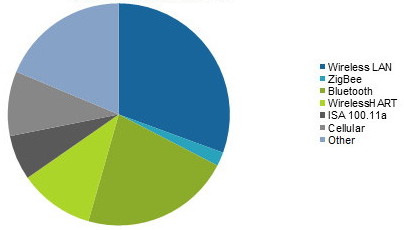- Home » News » Technology News
Bluetooth and WLANs capture 53% of the wireless market

More than half of all wireless-enabled industrial automation equipment shipped in 2012 used either Bluetooth or 802.11a/b/g/n wireless LAN (WLAN) technology, and these two standards are set to increase their domination of the market in the coming years.
WLANs accounted for 31% of shipments of wireless-enabled industrial automation equipment in 2012, while Bluetooth held 22% of the market, according a new report from IMS Research, now owned by IHS. It predicts that these market shares will continue to expand until 2017, at least.
The rest of the market is made up mainly of proprietary technologies, each accounting for relatively small percentages. Although these technologies are helping promote the adoption of wireless, they are making end-users cautious because of the lack of standardisation. IHS suggests that such caution is prudent, given the continuing battle between the various Ethernet and fieldbus systems.
“Users who want to implement wireless want a standard, unified solution they can rely on,” points out Tom Moore, an industrial communications analyst for IHS. “This is more difficult with proprietary solutions as there is less scope for interoperability. However, there are a number of more widely available technologies – such as Bluetooth, WirelessHart or ISA – which can answer to this.”
IHS argues that the biggest hurdle that wireless technology has yet to overcome is its perceived unreliability.
“Implementers don’t want a wireless network that’s unreliable,” Moore explains. “They believe that the current crop of technologies can be unreliable – but, in most cases, this isn’t true.

“Education through advertising and workshops will be essential to helping users understand that wireless can be very suitable for some applications,” he continues. “In most cases, these applications will be data gathering and monitoring, but control may likewise become an application as wireless technology progresses.”
At present, most wireless technologies targeting the industrial market use either the 2.4GHz band, or sub-GHz bands which can offer distance benefits. “The sub-GHz bands also have an advantage of being free from the busy 2.4GHz space, which is dominated by consumer products,” Moore points out. “By moving to this sub-GHz space, the bands are more freely available and can be cheaper to operate in.”
IHS believes that wireless “has the potential to be a great addition to a factory’s network. While still in the early phases of adoption, it has huge growth potential, especially as networks are similarly being upgraded to more modern Ethernet solutions.”





